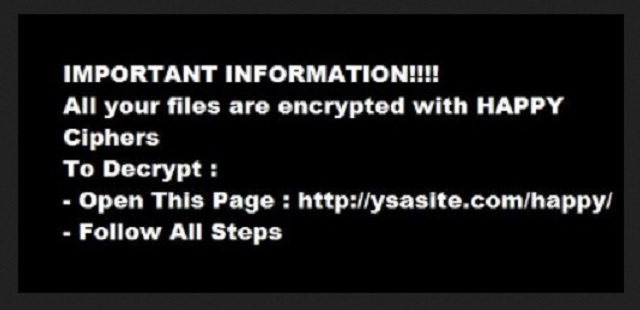I wrote this article to help you remove Happylocker Ransomware. This Happylocker Ransomware removal guide works for all Windows versions.
Happylocker ransomware is a win-locker from the Hidden Tear family. The insidious program targets different file types. It encrypts documents, spreadsheets, presentations, databases, archives, graphics, audios, videos and system components. A lot of common file formats are on the radar of Happylocker ransomware, including the following: .doc, .docx, .xls, .xlsx, .ppt, .pptx, .asp, .aspx, .pdf, .txt, .html, .avi, .wmv, .mov, .mpg, .mpeg, .mkv, .asf, .mp4, .flv, .cer, .ini, .bin, .dat, .sql, .pfx, .sln, .rtf, .wsc, .iff, .gif, .png, .bmp, .jpg, .jpeg, .psd, .tif, .tiff, .exif, .wps, .pak, .cdr, .rar, .zip, .sct, .raw, .m3u, .m4a, .csv, .dng, .bdf, .ai, .bat, .qic, .xml, .ps1, .reg, .mp3, .wav, .wma, .mid, .flac, .ogg, .lnk, .mdb, .db, .php, .js, .vb, .eps, .crw, .bkp, .eml, .odt, .arw.
Happylocker ransomware is named after the extension it adds to the targeted files. Upon encrypting a file, the insidious program appends the .happy suffix after its original name. When the win-locker has completed the encryption process, it drops a ransom note on the desktop and changes the background image to a custom wallpaper. The ransom note is called READDDDDDD.txt, while the image is titled READ.bmp. The two files contain an identical message. Their purpose is to introduce the win-locker and prepare the victim mentally. The cyber criminals behind Happylocker ransomware are focused on the task at hand. They do not bother to make threats or set a deadline.
Happylocker ransomware uses the AES-256 cryptosystem to lock files. This is a sophisticated cipher which is difficult to crack. The developers of the win-locker have a reason to be confident about their software. The ransom note directs to a Tor browser page which provides instructions on the payment process. The web page resembles the payment portal of Locky ransomware. A lot of win-lockers have borrowed the design of this encryption virus, perhaps because it is the leader for 2016. The owners of Happylocker ransomware require victims to pay them 0.1 bitcoins for the decryption key. This equals $73.31 USD, according to the current exchange rate.

The developers of Happylocker ransomware accept bitcoins and use the Tor web browser for security reasons. This cryptocurrency protects the identity of the recipient. The Tor program prevents tracking. As the message states, there are a lot of bitcoin vendors. Buying the required currency would not be a problem. Users are advised to register a bitcoin wallet in order to facilitate the procedure. Confirming the transaction can take up to 30 minutes. When it has been accepted, the decryptor will be activated.
Happylocker ransomware does not make users wait long upon making the payment. The process has been facilitated, compared to other win-lockers. Victims do not have to contact the proprietors of the malevolent program. The amount of the ransom is lower than the average. Happylocker ransomware does not put people through much trouble, compared to other encryption viruses. Of course, this does not mean that you should pay the ransom. Be advised that there is always a chance for the hackers to double cross you.
Happylocker ransomware is distributed in unconventional ways. The win-locker has adopted a couple of hosts. The first method for spreading the virus is through the Instant Satoshi BOT application. This tool is found on the darkweb. It offers people the chance to earn money by completing tests, filling in fields, distinguishing images and other tasks which are conducted to identify spybots. Completing the assignments Instant Satoshi BOT instructs you to do would infect your computer with the win-locker.
The other way for Happylocker ransomware to enter your system is through a software bundle. While this technique is common, the host is unique. If you contacted Happylocker ransomware through this host, you would already be familiar with bitcoins. The malevolent program travels with a fake bitcoin service application, spread by unreliable websites. The executable of this tool carries the setup file of the win-locker. You need to be careful with the software you add to your computer. Do your research on unfamiliar programs to make sure they have a good reputation.
Happylocker Ransomware Removal
Method 1: Restore your encrypted files using ShadowExplorer
Usually, Happylocker Ransomware deletes all shadow copies, stored in your computer. Luckily, the ransomware is not always able to delete the shadow copies. So your first try should be restoring the original files from shadow copies.
- Download ShadowExplorer from this link: http://www.shadowexplorer.com/downloads.html.
- Install ShadowExplorer
- Open ShadowExplorer and select C: drive on the left panel

- Choose at least a month ago date from the date field
- Navigate to the folder with encrypted files
- Right-click on the encrypted file
- Select “Export” and choose a destination for the original file
Method 2: Restore your encrypted files by using System Restore
- Go to Start –> All programs –> Accessories –> System tools –> System restore
- Click “Next“

- Choose a restore point, at least a month ago
- Click “Next“
- Choose Disk C: (should be selected by default)
- Click “Next“. Wait for a few minutes and the restore should be done.
Method 3: Restore your files using File Recovery Software
If none of the above method works, you should try to recover encrypted files by using File Recovery Software. Since Happylocker Ransomware first makes a copy of the original file, then encrypts it and deletes the original one, you can successfully restore the original, using a File Recovery Software. Here are a few free File Recovery Software programs:

